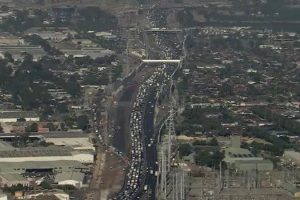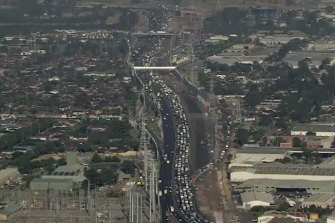Traffic jams are back as commuters shun public transport

Melbourne traffic is almost back to pre-COVID levels despite many people still working from home, with commuters choosing to drive in rather than take a train or tram.
The increased number of road users was one factor behind a massive snarl-up on the West Gate Bridge on Thursday morning, with traffic snaking back for 17 kilometres.
The West Gate traffic jam stretched for 17 kilometres on Thursday morning.Credit:Nine News
The hold up on the West Gate, as more people return to work in the city after lockdown restrictions eased, even brought an apology from Premier Daniel Andrews.
“A whole lot of people who needed to get where they were going, couldn’t get there in a good time,” Mr Andrews said. “I am upset about that, I deeply regret that.”
Figures from the Department of Transport show road utilisation across the city on Monday was at 92 per cent of pre-COVID baseline levels, a 1 per cent week-on-week increase.
The clogged roads came despite many city offices remaining largely empty – City of Melbourne foot traffic sensors show pedestrian activity this week is at one third of the pre-COVID benchmark.
Commuters are continuing to avoid public transport, with Department of Transport figures showing usage on Thursday was at 53 per cent of pre-COVID levels.
By contrast, Melbourne’s roads have been jammed, with Hoddle Street southbound between Johnston Street and Langridge Street between 8am and 9am on Monday recording traffic volume of 2897 vehicles and an average speed of 17km/h.
Two years ago, before the coronavirus pandemic hit, the traffic volume at the same spot was 2797 vehicles with an average speed of 15km/h.
On the Monash Freeway inbound between Warrigal Road and High Street on Monday the traffic volume was 5432 vehicles with an average speed of 66km/h.
Two years ago the traffic volume was 6160 vehicles with an average speed of 42km/h.
A spokeswoman for the Department of Transport said the data showed noticeable changes in how Melburnians had used the road network as the pandemic evolved.
“Traffic volumes outside of lockdown periods have remained closer to pre-COVID levels on the arterial road network, but we are now seeing volumes return nearer to pre-COVID levels across Melbourne’s freeways” she said.
Thursday morning’s congestion on the West Gate Freeway during peak hour, was caused by the road being down to one lane inbound from Williamstown Road.
At a press conference on Thursday morning Mr Andrews apologised for the delays which he said were due to construction work.
“We do a lot of work overnight and the team’s worked as hard as they can to clear all that up for the morning and there’s some things that went wrong overnight and that didn’t happen,” he said.
Data from HERE Analytics which used in-car GPS data to track travel times on the West Gate over the past couple of days showed travel times blew out with commuters between Grieve Parade and Power Street spending an extra 18 minutes in their cars on Wednesday between 9am and 1pm and an extra 56 minutes on Thursday.
Majid Sarvi, Professor of Transport for Smart Cities at the University of Melbourne said fewer people were working in the city and moving around and when they did go into the CBD they were avoiding public transport.
“They’re driving so you see a lot of congestion on roads,” he said. “Basically it’s going to get worse if people keep using cars and private transport instead of public transport.”
Professor Sarvi said many people appeared to be reluctant to catch a train, tram or bus because of the pandemic and needed encouragement to return to public transport or to cycle or walk.
“It’s not just in Melbourne,” he said. “It’s a phenomenon everywhere of people who are avoiding public transport.”
The Morning Edition newsletter is our guide to the day’s most important and interesting stories, analysis and insights. Sign up here.
Most Viewed in National
From our partners
Source: Read Full Article

